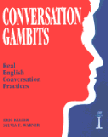

| Book of the Month | ||
 | Conversation Gambits |  |
Publisher: Language Teaching Publications
Authors: Eric Keller, Sylvia T. Warner
95 pages
Price £8.50
ISBN 0 906717 59 0
Let's talk! The summer holidays are coming, and if you are going out of your country, then you will need to speak to people in the world language - English. So we have found you a conversation course guide to make your conversation more natural and fluent.
The full title of the book is Conversation Gambits - real English conversation practices. You will notice that most British speakers would say 'practice exercises', but this book was first published in Canada, and there are a few signs of American English in the text, but not enough for this to be a real problem for people who want to use British English.
The book has 63 exercises. They are arranged in three sections - opening gambits, linking gambits, and responding gambits. (In a moment we will explain what is meant by 'gambits'). Within each section you have exercises for the sort of thing you might have to do in real English - for example, how to break into a conversation, how to get information on the phone, how to explain your opinion, or disagree with someone else's opinion. These are really useful. It is a pity, though, that they are hard to find, because the exercises are given silly chapter headings on the contents page. e.g. 'I haven't a clue!' for explaining that you don't know something.
So what is a 'conversation gambit'? Most languages use gambits. They are a way of telling the person who is listening to you what you are going to say. So if you are going to give your opinion, you might start by saying "in my opinion ...": if you want to tell some bad news, you might start "I am afraid I have bad news ...". These are gambits. They are different in every language, and your English will not be fluent until you can use them naturally.
That is what this book is all about. It does not try to teach whole conversations. Instead it sets up a situation where you have to use certain conversation gambits. Many of these are the sort of exercises you might find in any text book, for example, you might have to discuss the advantages of a nuclear power station being built near your village (more jobs, cheap electricity) and the disadvantages (danger of accidents, nuclear pollution). The edges of the pages are grey. On these edges the gambits you should use are written. (In this case, you would use things like 'on the other hand', 'the good thing is ..' and so on.) There are not many pictures in the book. Those which you do get are black and white, and they are not decoration - they are a part of the exercise that you have to do. Often they are diagrams.
The main problem with this book is that it does not give you any paradigms for each conversation. It would have been useful for a student working alone to be able to turn to the back of the book, and see an example of how the conversation would have happened with real English speakers. Also, many of the examples need more than one speaker, which shows that this book is really for use in a classroom. This also shows in the price - £8.50 is a lot to pay for a book that just does one part (gambits) of one part of learning English (conversation). But if it is used by three teachers once a week for a year, (and it easily can be) then it is very good value. This does not mean that individual learners can't use the book - but it is more difficult than a book designed for self-study would be.
The level is intermediate or above, but unless your conversation is very good, you can learn something from this book. Remember good use of gambits wins you lots of points in the speaking part of the Cambridge exams, so teachers and students who have the exam coming soon might find this book a good investment. The web page which gives details about the book is a good one, and it has example pages which seem to be photocopies from the book - so you know exactly what the book is like. One of the EFL teachers who works with English for Everybody liked the book so much that he got it for his class. If you are an English teacher, its worth a look. If you study by yourself, well, on the one hand, there are no example conversations, you needs someone to work with, and it's quite expensive. But on the other hand, the gambits are useful, an important part of English, and we don't know any other book that does this so well.
Verdict Good for teachers. Individual students can see examples on the website and decide for themselves.
Assessment 8/10